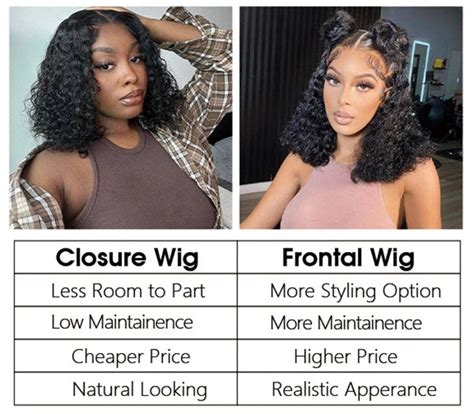When choosing a hair system, understanding the difference between closure and frontal is crucial for achieving a natural and seamless look. Here’s an in-depth guide to help you make an informed decision:

1. What is a Closure?
A closure is a small, round or oval-shaped piece of material, typically lace or silk, that covers a bald or thinning area at the top of the head. It contains individual strands of hair knotted onto it to create an illusion of naturally growing hair.
Types of Closures:
- Lace Closure: A lace base closure that allows for versatile styling options.
- Silk Closure: A silk base closure that provides a soft and breathable base.
- Poly Closure: A poly material base closure that is lightweight and durable.
2. What is a Frontal?
A frontal is a larger piece of material that covers the entire front of the head, from ear to ear. It contains multiple rows of hair attached to the base to mimic a full hairline.
Types of Frontals:
- Lace Frontal: A lace base frontal that offers flexibility and lace customization.
- Silk Frontal: A silk base frontal that provides a natural scalp illusion.
- Poly Frontal: A poly material base frontal that is often used for longer-term wear.
3. Pros and Cons of Closures vs. Frontals
Closures:
-
Pros:
- Smaller and less noticeable.
- More affordable than frontals.
- Allow for custom parting.
- Provide volume and coverage for specific areas.
-
Cons:
- May not cover larger bald areas.
- Can shift or detach during styling.
- Requires regular maintenance and blending.
Frontals:
-
Pros:
- Creates a full hairline and covers a larger area.
- Provides a more natural-looking scalp illusion.
- Allows for unlimited styling possibilities.
- Enhances overall volume and thickness.
-
Cons:
- More expensive than closures.
- Can be heavier and less comfortable to wear.
- Requires more skilled installation and maintenance.
4. Which Hair System Is Right for You?
The best choice between a closure and a frontal depends on your individual preferences and needs.
-
Consider a closure if:
- You have a small area of thinning or baldness.
- You prefer a more subtle and cost-effective solution.
- You want a versatile option for styling.
-
Consider a frontal if:
- You have a receding hairline or a large area of hair loss.
- You desire a more permanent and cohesive look.
- You enjoy the freedom to experiment with different hairstyles.
5. Common Mistakes to Avoid
- Choosing the wrong size or shape: Consult with a professional hair stylist to determine the best fit for your head.
- Over-tightening the closure or frontal: This can cause discomfort and damage to your scalp.
- Using adhesive that is too strong: Avoid using industrial-strength adhesives, which can be difficult to remove and damaging to hair.
- Not blending properly: Seamlessly blend the hair system with your existing hair to create a natural appearance.
- Ignoring maintenance: Regular cleaning, conditioning, and styling are essential for extending the life of your hair system.
6. FAQs
- Which is more durable, a closure or a frontal? Frontals tend to be more durable due to their larger size and multiple hair attachments.
- Can I color a closure or frontal? Yes, most hair systems can be colored by a professional hair stylist. However, avoid using harsh chemicals, as this can damage the hair.
- How long does a hair system last? The lifespan of a hair system varies depending on the quality, usage, and maintenance. With proper care, a closure or frontal can last for 6-12 months or even longer.
- Is it easy to install a hair system? Installing a hair system requires skill and experience. It is generally recommended to have it professionally installed and maintained.
- Can I swim or exercise with a hair system? Yes, but with caution. Avoid excessive water exposure and vigorous activities that may dislodge the system.
- How much does a closure or frontal cost? Closures typically range from $100-$200, while frontals can cost anywhere from $200-$500.
7. Creative New Word: “Synthehair”
Combining the words “synthetic” and “hair,” “synthehair” refers to the innovative materials used in modern hair systems. These materials mimic the texture, luster, and durability of natural hair, offering unparalleled comfort and versatility.
8. Useful Tables
Table 1: Closure vs. Frontal Comparison
| Feature | Closure | Frontal |
|---|---|---|
| Size | Small, round or oval | Covers front of head |
| Coverage | Specific areas | Full hairline |
| Versatility | Custom parting | Unlimited styling |
| Cost | Affordable | Expensive |
| Maintenance | Regular | More skilled |
Table 2: Types of Closures and Frontals
| Type | Material | Benefits |
|---|---|---|
| Lace Closure | Lace | Versatile styling, lightweight |
| Silk Closure | Silk | Soft, breathable base |
| Poly Closure | Polyurethane | Durable, less visible |
| Lace Frontal | Lace | Natural scalp illusion, flexibility |
| Silk Frontal | Silk | Comfortable, realistic appearance |
| Poly Frontal | Polyurethane | Long-term wear, minimal shifting |
Table 3: Pain Points and Motivations
| Pain Point | Motivation |
|---|---|
| Thinning hair | Desire for volume and coverage |
| Hair loss | Regain confidence and self-esteem |
| Receding hairline | Restore a youthful appearance |
| Baldness | Improve overall well-being and quality of life |
Table 4: Common Mistakes and Solutions
| Mistake | Solution |
|---|---|
| Improper sizing | Consult with a professional for the best fit |
| Over-tightening | Use the correct amount of adhesive |
| Incorrect blending | Gradually blend the hair system with your natural hair |
| Irregular maintenance | Establish a regular cleaning and conditioning routine |
| Harsh chemical treatments | Avoid using bleach or other damaging hair products |
